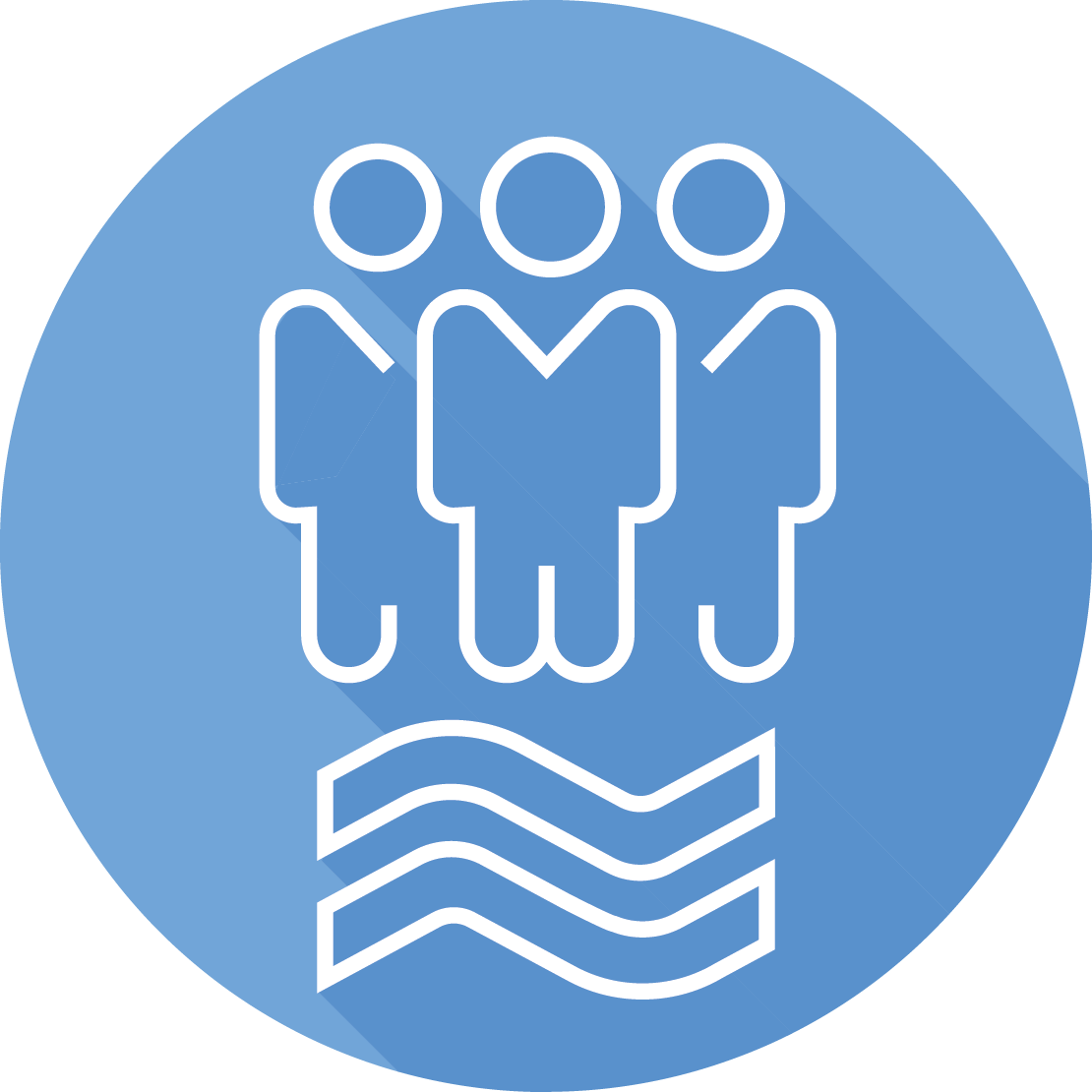The subject of national attention due to concerns about potential health impacts, PFAS is a group of man-made chemicals that have been widely used for decades in industry and consumer goods. As part of our steadfast commitment to providing reliable, high-quality drinking water, we want you to know what we do to safeguard our water supply from PFAS pollution. We are following and participating in policy and scientific research regarding PFAS, and remain confident in the safety of our high-quality tap water.

PFAS: What Are They?
- Human-made perfluoroalkyl and polyfluoroalkyl substances, commonly called PFAS, have been used in industrial applications and a wide range of consumer products involving cookware, food packaging, water and stain resistant fabrics, paper products and firefighting foams.
- PFAS substances have been used globally for decades and do not break down easily or quickly. PFAS are widespread around the world, even found in remote environments such as the Arctic.
- There are thousands of PFAS compounds. Initial research suggests some types of PFAS may be linked to health problems.

Customer and Safety Concerns
- In Connecticut, there have been media reports of PFAS detected in the Connecticut River and other waterways. Fortunately, none of these significant PFAS pollution events have affected drinking water sources.
- While there are no federal or state drinking water regulations for PFAS in Connecticut, the EPA set a health advisory level as a guideline in 2016. Connecticut has set a drinking water Action Level in 2022 for each of four (4) PFAS compounds: PFOS, PFOA, PFNA and PFHxS.

RWA Actions
- The RWA conducts a rigorous schedule of source water testing to ensure our water is safe and of the highest quality. We also go to great lengths to protect the lands our water is sourced from.
- While PFAS are not currently regulated, the RWA proactively tested for PFAS in our source waters since 2019. We found that any presence of PFAS in our source waters is well below Connecticut’s health advisory limits, further reaffirming the safety and high quality of our water.
- Through our watershed and aquifer inspection program, we updated our water supply plan inventory of land use activities to include potential PFAS generators in our watershed and aquifer areas to assist us in the identification of potential areas of concern should they be close to one of our water resources. Sites identified as potential PFAS generators have been prioritized for inspection.
- We are collaborating with Connecticut’s inter-agency task force and our local water industry partners to better understand the influence of source water contamination and stay on top of the latest scientific information.
- We have been in close communication with local health departments and the state Department of Public Health to provide an overview of the RWA’s PFAS monitoring and testing. They are satisfied with the RWA’s current efforts to ensure our drinking water is safe and of the highest quality.
- The RWA continues to follow the state and national discussion and latest scientific discoveries to ensure the integrity of our water supply.
- The RWA’s state-of-the-art laboratory is one of only two licensed labs in Connecticut approved to test drinking water for PFAS.

RWA PFAS Testing Results
PFAS pollution is common in the environment due to its use in a large range of products. The RWA's environmental protection efforts have successfully limited the impact these chemicals have on our water sources.
Although the DPH does not currently require that utilities test for PFAS or make results public, the RWA proactively tested all of our sources of supply. While we detected low levels of PFAS, we continue working with local health departments, state agencies, and our internal experts to investigate environmental and treatment strategies that will remove additional PFAS from our high-quality water supply.
Regional Water Authority PFAS Sampling Result Data - March 2023
*Connecticut Department of Health Action Levels
- For surface plants, the value represents water distributed to customers
- For the aquifers, this data is an average of raw water from individual wells located at multiple well fields
![]()
Our PFAS testing measures in parts per trillion, which is an amount roughly equivalent to one droplet of water in a 43-foot-deep pool covering a football field.

- AWWA Briefing on PFAS
- Centers for Disease Control on PFAS
- Connecticut Interagency PFAS Task Force Action Plan
- Connecticut Interagency PFAS Task Force Action Plan - Appendix
- Department of Public Health on PFAS
- Deparment of Public Health Drinking Water Section PFAS Strategy
- Department of Public Health PFAS Health Concerns
- FAQs
- RWA Lab Services
- Water Quality FAQs

The subject of national attention due to concerns about potential health impacts, PFAS is a group of man-made chemicals that have been widely used for decades in industry and consumer goods. As part of our steadfast commitment to providing reliable, high-quality drinking water, we want you to know what we do to safeguard our water supply from PFAS pollution. We are following and participating in policy and scientific research regarding PFAS, and remain confident in the safety of our high-quality tap water.

PFAS: What Are They?
- Human-made perfluoroalkyl and polyfluoroalkyl substances, commonly called PFAS, have been used in industrial applications and a wide range of consumer products involving cookware, food packaging, water and stain resistant fabrics, paper products and firefighting foams.
- PFAS substances have been used globally for decades and do not break down easily or quickly. PFAS are widespread around the world, even found in remote environments such as the Arctic.
- There are thousands of PFAS compounds. Initial research suggests some types of PFAS may be linked to health problems.

Customer and Safety Concerns
- In Connecticut, there have been media reports of PFAS detected in the Connecticut River and other waterways. Fortunately, none of these significant PFAS pollution events have affected drinking water sources.
- While there are no federal or state drinking water regulations for PFAS in Connecticut, the EPA set a health advisory level as a guideline in 2016. Connecticut has set a drinking water Action Level in 2022 for each of four (4) PFAS compounds: PFOS, PFOA, PFNA and PFHxS.

RWA Actions
- The RWA conducts a rigorous schedule of source water testing to ensure our water is safe and of the highest quality. We also go to great lengths to protect the lands our water is sourced from.
- While PFAS are not currently regulated, the RWA proactively tested for PFAS in our source waters since 2019. We found that any presence of PFAS in our source waters is well below Connecticut’s health advisory limits, further reaffirming the safety and high quality of our water.
- Through our watershed and aquifer inspection program, we updated our water supply plan inventory of land use activities to include potential PFAS generators in our watershed and aquifer areas to assist us in the identification of potential areas of concern should they be close to one of our water resources. Sites identified as potential PFAS generators have been prioritized for inspection.
- We are collaborating with Connecticut’s inter-agency task force and our local water industry partners to better understand the influence of source water contamination and stay on top of the latest scientific information.
- We have been in close communication with local health departments and the state Department of Public Health to provide an overview of the RWA’s PFAS monitoring and testing. They are satisfied with the RWA’s current efforts to ensure our drinking water is safe and of the highest quality.
- The RWA continues to follow the state and national discussion and latest scientific discoveries to ensure the integrity of our water supply.
- The RWA’s state-of-the-art laboratory is one of only two licensed labs in Connecticut approved to test drinking water for PFAS.

RWA PFAS Testing Results
PFAS pollution is common in the environment due to its use in a large range of products. The RWA's environmental protection efforts have successfully limited the impact these chemicals have on our water sources.
Although the DPH does not currently require that utilities test for PFAS or make results public, the RWA proactively tested all of our sources of supply. While we detected low levels of PFAS, we continue working with local health departments, state agencies, and our internal experts to investigate environmental and treatment strategies that will remove additional PFAS from our high-quality water supply.
Regional Water Authority PFAS Sampling Result Data - March 2023
*Connecticut Department of Health Action Levels
- For surface plants, the value represents water distributed to customers
- For the aquifers, this data is an average of raw water from individual wells located at multiple well fields
![]()
Our PFAS testing measures in parts per trillion, which is an amount roughly equivalent to one droplet of water in a 43-foot-deep pool covering a football field.


